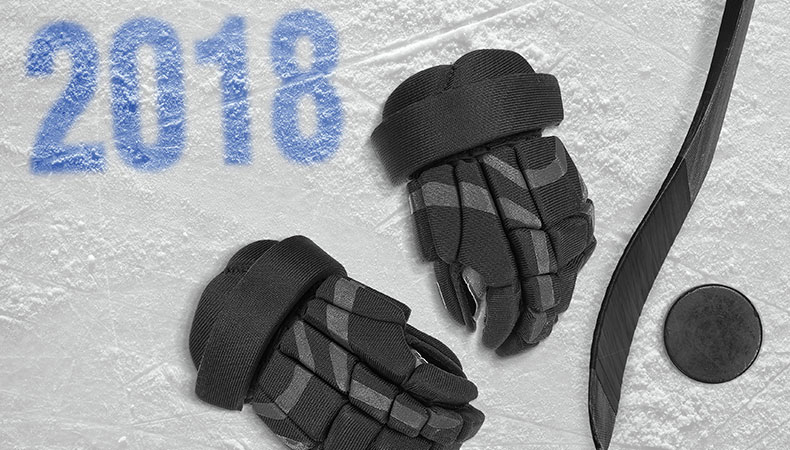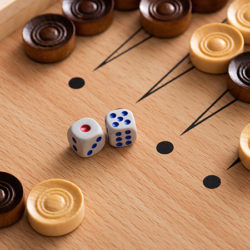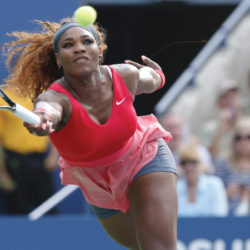
Getting the top pick in the NHL draft is a big deal for NHL teams and fans. Each year the league holds a lottery to determine the order teams receive draft picks. To discourage teams from purposely losing to guarantee the top pick, all 15 teams that didn’t make the playoffs are placed in a lottery for the top three picks. The lottery uses numbered ping-pong balls to generate random 4-digit sequences where each team is assigned a number of 4-digit sequences proportional to their odds of winning. The odds of getting a top pick vary inversely based on the place in which a team finished.
This year the NHL tried something new that increased the suspense for fans. The league ran the lottery and announced the teams that received a top-three pick but waited almost three hours to announce the order. During this time, fans and media members took guesses at the probability that the Buffalo Sabres (who finished in last place this season) got the top pick after hearing that they were among the top three. Many people came to incorrect conclusions. At the end of this article I will go through the calculations to solve for this probability. Before you read the answer, test yourself to see if you can get it right.
The Setup
The odds for the lottery are in the table below (odds are shown for the team that originally owned the pick if it was traded).
| Team | Odds of Winning First Pick |
| Buffalo | 18.5% |
| Ottawa | 13.5% |
| Arizona | 11.5% |
| Montreal | 9.5% |
| Detroit | 8.5% |
| Vancouver | 7.5% |
| Chicago | 6.5% |
| New York Rangers | 6.0% |
| Edmonton | 5.0% |
| New York Islanders | 3.5% |
| Carolina | 3.0% |
| Calgary | 2.5% |
| Dallas | 2.0% |
| Philadelphia | 1.5% |
| Florida | 1.0% |
The team that wins the first pick can’t win later picks, so there is a redraw if one of their permutations is picked later. With this structure, a team’s odds of winning the second pick depend on which team wins the first pick. For example, Ottawa has a 13.5/(100-18.5)= 16.6% chance at the second pick if Buffalo wins the first pick, but only 13.5/(100-1)= 13.6% if Florida wins the first pick.
During the NHL Draft Lottery at 7:30pm EST on Saturday, April 28th, the league announced that Buffalo, Montreal, and Carolina each had won one of the top three picks. Given this information, what is the probability Buffalo got the top pick?
The probability each team has the first pick can be calculated using conditional probability. There are six ways the top three picks could be ordered for these three teams. The probability a specific team has of winning the top pick is equal to the sum of the probability of the two outcomes where that specific team wins the first pick, divided by the probability those three teams were picked.
For example, to solve for the probability that the team order was Buffalo 1st, Montreal 2nd, and Carolina 3rd you perform the following calculations:
P(BUF 1) = 18.5% (From table above)
P(CAR 1) = 3%
P(MTL 1) = 9.5%
P(MTL 2 | BUF 1) = P(MTL 1) / (1 – P(BUF 1))
P(CAR 3 | MTL 2 and BUF 1) = P(CAR 1) / (1 – P(BUF 1) – P(MTL 1))
P(BUF 1 and MTL 2 and CAR 3) = P(BUF 1) * P(MTL 2 | BUF 1) * P(CAR 3 | MTL 2 and BUF 1)
Doing this for each one of the six possible permutations gets the following results:
| Pick | Team | Probability of Team Winning Specified Pick | |
| 1 | BUF | =18.5/100 | 18.5% |
| 2 | MTL | =9.5/(100-18.5) | 11.7% |
| 3 | CAR | =3/(100-18.5-9.5) | 4.2% |
| Probability of Outcome | 0.0899% | ||
| 1 | BUF | =18.5/100 | 18.5% |
| 2 | CAR | =3/(100-18.5) | 3.7% |
| 3 | MTL | =9.5/(100-18.5-3) | 12.1% |
| Probability of Outcome | 0.0824% | ||
| 1 | MTL | =9.5/100 | 9.5% |
| 2 | BUF | =18.5/(100-9.5) | 20.4% |
| 3 | CAR | =3/(100-9.5-18.5) | 4.2% |
| Probability of Outcome | 0.0809% | ||
| 1 | MTL | =9.5/100 | 9.5% |
| 2 | CAR | =3/(100-9.5) | 3.3% |
| 3 | BUF | =18.5/(100-9.5-3) | 21.1% |
| Probability of Outcome | 0.0666% | ||
| 1 | CAR | =3/100 | 3.0% |
| 2 | BUF | =18.5/(100-3) | 19.1% |
| 3 | MTL | =9.5/(100-3-18.5) | 12.1% |
| Probability of Outcome | 0.0692% | ||
| 1 | CAR | =3/100 | 3.0% |
| 2 | MTL | =9.5/(100-3) | 9.8% |
| 3 | BUF | =18.5/(100-3-9.5) | 21.1% |
| Probability of Outcome | 0.0621% | ||
Now that you know the probability of each individual outcome, you can solve for the probability Buffalo had the top pick.
From the definition of conditional probability:
P(BUF MTL and CAR in Top 3)
P(BUF MTL and CAR in Top 3)
The results are summarized in the following table:
| Probability of Outcome with First Pick AND BUF, MTL, CAR in Top 3 | Probability of Top Pick GIVEN BUF, MTL, CAR in Top 3 | |
| BUF | 0.172% | 38.2% |
| MTL | 0.147% | 32.7% |
| CAR | 0.131% | 29.1% |
One of the ways some people tried to solve this problem was to re-weight the probability of the first pick from the probabilities for these three teams getting the first pick overall, so they said Buffalo would have the top pick with a probability of (18.5)/(18.5 + 9.5 + 3.0), or 59.7%. Others thought that once the three teams were chosen, they could have been in any order, so the probability that Buffalo (or any other team) had the top pick was 1/3, or 33.3%. Neither of these methods is correct, though.
What Happened
During the second intermission of the San Jose Sharks vs Las Vegas Golden Knights game, the NHL announced that Buffalo won the first pick, Carolina had the second pick, and Montreal had the third pick.




Subscribe Now
Get each new post sent straight to your inbox